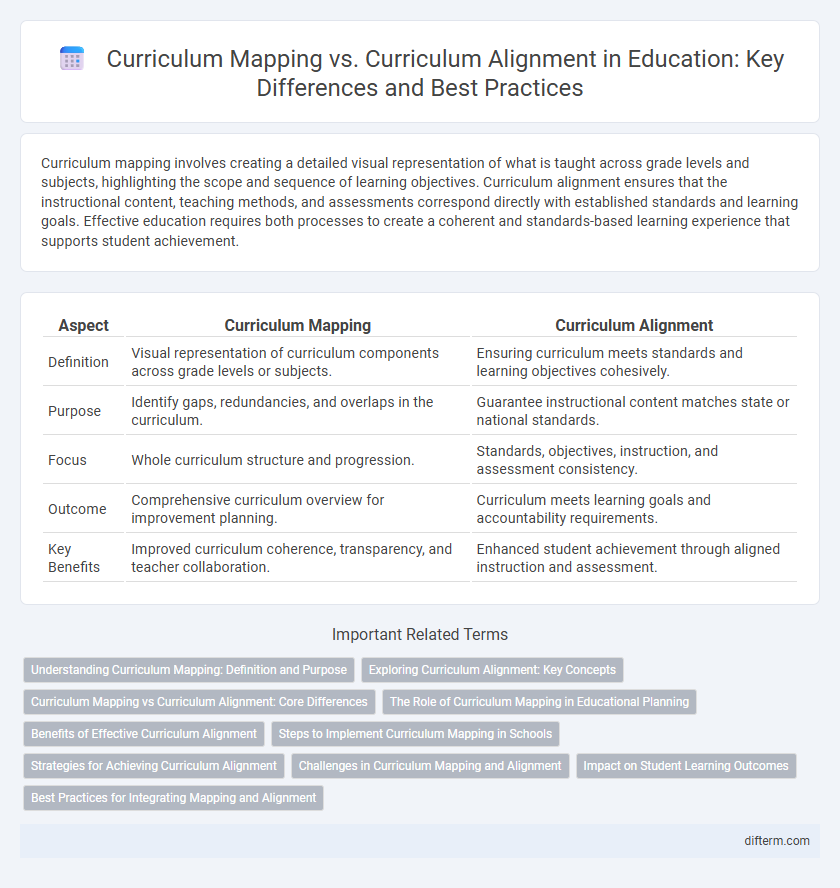Curriculum mapping involves creating a detailed visual representation of what is taught across grade levels and subjects, highlighting the scope and sequence of learning objectives. Curriculum alignment ensures that the instructional content, teaching methods, and assessments correspond directly with established standards and learning goals. Effective education requires both processes to create a coherent and standards-based learning experience that supports student achievement.
Table of Comparison
| Aspect | Curriculum Mapping | Curriculum Alignment |
|---|---|---|
| Definition | Visual representation of curriculum components across grade levels or subjects. | Ensuring curriculum meets standards and learning objectives cohesively. |
| Purpose | Identify gaps, redundancies, and overlaps in the curriculum. | Guarantee instructional content matches state or national standards. |
| Focus | Whole curriculum structure and progression. | Standards, objectives, instruction, and assessment consistency. |
| Outcome | Comprehensive curriculum overview for improvement planning. | Curriculum meets learning goals and accountability requirements. |
| Key Benefits | Improved curriculum coherence, transparency, and teacher collaboration. | Enhanced student achievement through aligned instruction and assessment. |
Understanding Curriculum Mapping: Definition and Purpose
Curriculum mapping is a systematic process used by educators to document and visualize what is taught across different grades and subjects, ensuring comprehensive coverage of standards and learning objectives. It serves to identify gaps, redundancies, and inconsistencies in the curriculum to promote coherent instruction and targeted student outcomes. Unlike curriculum alignment, which focuses on matching curriculum with assessments and standards, curriculum mapping provides a broader overview of the instructional content and pacing over time.
Exploring Curriculum Alignment: Key Concepts
Curriculum alignment ensures that learning objectives, instructional methods, and assessments are cohesively integrated to promote student achievement, whereas curriculum mapping visually represents this alignment by detailing the sequence and scope of content delivery. Exploring key concepts of curriculum alignment highlights the importance of coherence between standards, teaching practices, and evaluation strategies, fostering a unified educational experience. Ensuring all components collaborate effectively supports focused instruction and meaningful learning outcomes in educational settings.
Curriculum Mapping vs Curriculum Alignment: Core Differences
Curriculum mapping involves creating a detailed visual representation of what is taught across different grades and subjects, highlighting learning objectives, content, and assessments to identify gaps and redundancies. Curriculum alignment focuses on ensuring that teaching methods, assessments, and learning outcomes are consistently linked with state standards and educational goals. The core difference lies in curriculum mapping providing a comprehensive overview for analysis, while curriculum alignment ensures coherence and consistency between curriculum components and standards.
The Role of Curriculum Mapping in Educational Planning
Curriculum mapping plays a critical role in educational planning by providing a detailed visual representation of the content, skills, and assessments across grade levels and subjects, enabling educators to identify gaps, redundancies, and inconsistencies in the instructional sequence. Unlike curriculum alignment, which ensures that curriculum matches standards and assessments, curriculum mapping serves as a dynamic tool for continuous improvement and collaboration among teachers, supporting data-driven decisions to enhance student learning outcomes. This systematic process fosters coherence and transparency in the curriculum, ultimately aiding schools in meeting educational goals and standards efficiently.
Benefits of Effective Curriculum Alignment
Effective curriculum alignment ensures that learning objectives, instructional activities, and assessments are consistently connected, enhancing student comprehension and retention. It promotes clear communication among educators, fostering collaborative teaching strategies and data-driven instruction. This alignment supports improved educational outcomes by targeting skill mastery and reducing gaps in student learning paths.
Steps to Implement Curriculum Mapping in Schools
Curriculum mapping involves documenting what is taught and when, using detailed guides that track instructional content and assessment across grade levels. Steps to implement curriculum mapping in schools include identifying essential standards, gathering teacher input to create comprehensive maps, and regularly reviewing and updating the maps to ensure consistency and address learning gaps. This process supports curriculum alignment by making instructional practices transparent and cohesive throughout the school system.
Strategies for Achieving Curriculum Alignment
Curriculum mapping involves creating a visual representation of what is taught and when, while curriculum alignment ensures that instructional goals, assessments, and materials are coherent and support learning objectives. Strategies for achieving curriculum alignment include establishing clear learning standards, employing backward design to connect assessments with outcomes, and fostering continuous collaboration among educators for consistent curriculum updates. Utilizing tools like curriculum matrices and regular data analysis enhances the alignment process, promoting improved student achievement.
Challenges in Curriculum Mapping and Alignment
Curriculum mapping faces challenges such as inconsistent implementation, limited faculty collaboration, and difficulties in maintaining updated maps aligned with learning outcomes. Curriculum alignment struggles with ensuring coherence between standards, assessments, and instruction, often hindered by varying interpretation among educators. Both processes require continuous professional development and robust communication to overcome obstacles and achieve effective curriculum integration.
Impact on Student Learning Outcomes
Curriculum mapping establishes a comprehensive overview of instructional content across grades and subjects, ensuring consistency and identifying gaps that hinder student progress. Curriculum alignment tightly connects learning objectives, assessments, and instructional methods, directly enhancing the relevance and coherence of student learning experiences. Both processes significantly impact student learning outcomes by promoting targeted skill development and improving academic achievement through structured and intentional curriculum design.
Best Practices for Integrating Mapping and Alignment
Integrating curriculum mapping and curriculum alignment involves systematically documenting learning objectives and matching them with standards, assessments, and instructional strategies to create a cohesive educational framework. Best practices include continuous collaboration among educators to ensure vertical and horizontal alignment, leveraging data analytics for identifying gaps, and regularly updating maps to reflect evolving standards and learner needs. This holistic approach promotes consistency, accountability, and enhanced student outcomes across all grade levels and subjects.
curriculum mapping vs curriculum alignment Infographic

 difterm.com
difterm.com